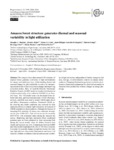Please use this identifier to cite or link to this item:
http://www.alice.cnptia.embrapa.br/alice/handle/doc/1046806| Title: | Amazon forest structure generates diurnal and seasonal variability in light utilization. |
| Authors: | MORTON, D. C.  RUBIO, J.   COOK, B. D.   GASTELLU-ETCHEGORRY, J-P   LONGO, M.   CHOI, H.   HUNTER, M.   KELLER, M.   |
| Affiliation: | DOUGLAS C. MORTON, NASA; JEREMY RUBIO, NASA - Université de Toulouse; BRUCE D. COOK, NASA; JEAN-PHILIPPE GASTELLU-ETCHEGORRY, Université de Toulouse; MARCOS LONGO, BOLSISTA CNPM; HYEUNGU CHOI, Global Science & Technology Inc.; MARIA HUNTER, University of New Hampshire; MICHAEL KELLER, USDA Forest Service/ Pesquisador visitante CNPM. |
| Date Issued: | 2016 |
| Citation: | Biogeosciences, v. 13, p. 2195?2206, 2016. |
| Description: | The complex three-dimensional (3-D) structure of tropical forests generates a diversity of light environments for canopy and understory trees. Understanding diurnal and seasonal changes in light availability is critical for interpreting measurements of net ecosystem exchange and improving ecosystem models. Here, we used the Discrete Anisotropic Radiative Transfer (DART) model to simulate leaf absorption of photosynthetically active radiation (lAPAR) for an Amazon forest. The 3-D model scene was developed from airborne lidar data, and local measurements of leaf reflectance, aerosols, and PAR were used to model lAPAR under direct and diffuse illumination conditions. Simulated lAPAR under clear-sky and cloudy conditions was corrected for light saturation effects to estimate light utilization, the fraction of lAPAR available for photosynthesis. Although the fraction of incoming PAR absorbed by leaves was consistent throughout the year (0.80?0.82), light utilization varied seasonally (0.67?0.74), with minimum values during the Amazon dry season. Shadowing and light saturation effects moderated potential gains in forest productivity from increasing PAR during dry-season months when the diffuse fraction from clouds and aerosols was low. Comparisons between DART and other models highlighted the role of 3-D forest structure to account for seasonal changes in light utilization. Our findings highlight how directional illumination and forest 3-D structure combine to influence diurnal and seasonal variability in light utilization, independent of further changes in leaf area, leaf age, or environmental controls on canopy photosynthesis. Changing illumination geometry constitutes an alternative biophysical explanation for observed seasonality in Amazon forest productivity without changes in canopy phenology. |
| NAL Thesaurus: | Tropical forests |
| DOI: | 10.5194/bg-13-2195-2016 |
| Type of Material: | Artigo de periódico |
| Access: | openAccess |
| Appears in Collections: | Artigo em periódico indexado (CNPM)  |










